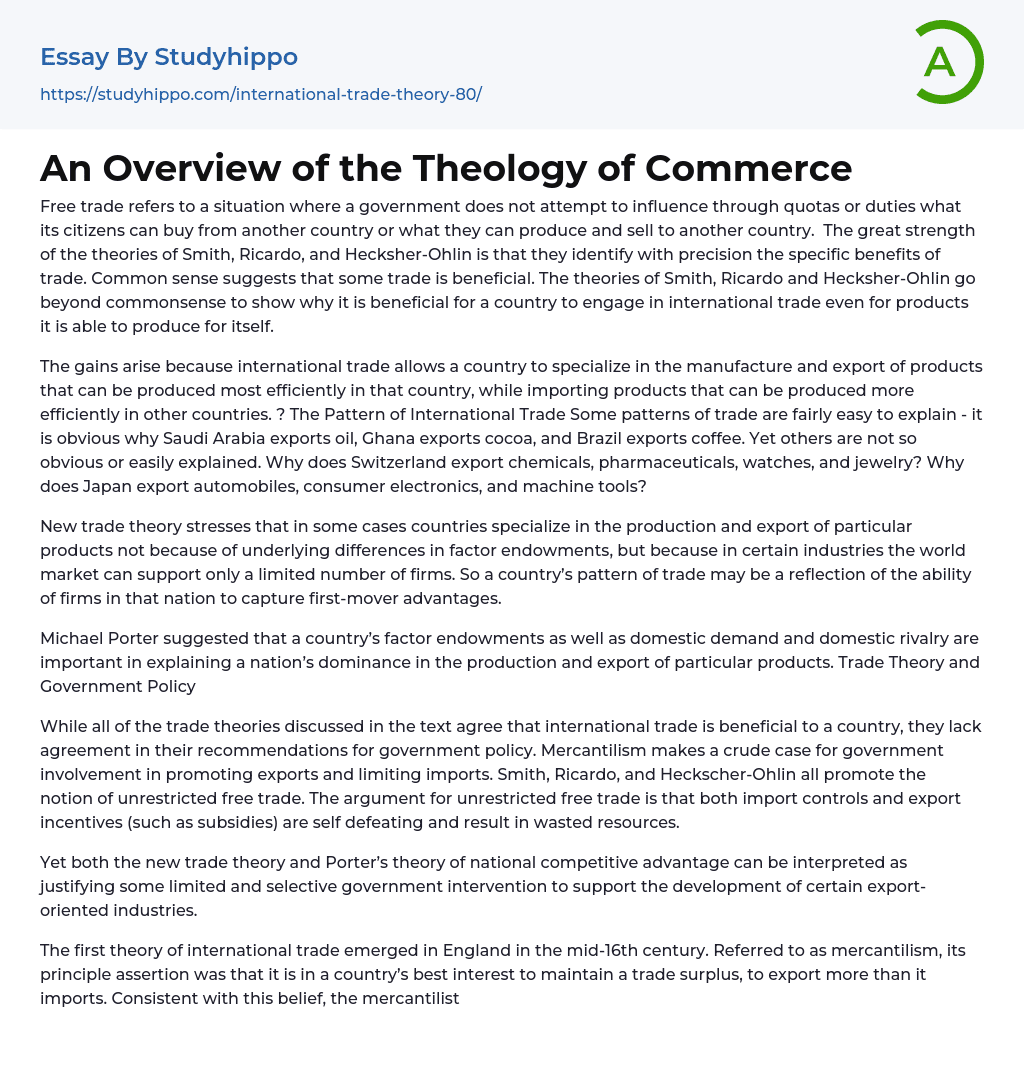Free trade is the absence of government regulation in citizens' transactions with foreign nations. The theories of Smith, Ricardo, and Hecksher-Ohlin explain the advantages of trade. While it may seem clear that trade is beneficial, these theories offer insight into why a country should participate in global trade for goods it can already produce domestically.
The benefits of international trade arise when a country concentrates on producing and selling products that it can manufacture most efficiently within its borders, while also importing products that are more efficiently produced in other countries. Examples of this trade pattern include Saudi Arabia exporting oil, Ghana exporting cocoa, and Brazil exporting coffee. However, there are instances that are not as easily explained. For example, Switzerland exports chemicals, pharmaceuticals, watches, and jewelry; whereas Japan exports automobiles, consumer electronics, and machine tools. The new trade theory suggests that cou
...ntries specialize in certain products because of differences in resources and the limited number of firms the global market can support in specific industries. Hence, a country's trade pattern reflects its firms' ability to take advantage of being first movers. Michael Porter further argues that a country's available resources (factor endowments), domestic demand, and domestic competition play significant roles in explaining why certain countries dominate the production and exportation of specific products.
The text discusses various trade theories and their recommendations for government policy. While they all agree that international trade is beneficial, they have different views on how the government should be involved.
Mercantilism argues for government promotion of exports and restrictions on imports. On the other hand, Smith, Ricardo, and Heckscher-Ohlin advocate for unrestricted free trade, considering import controls and export incentives as wasteful.
However
the new trade theory and Porter's theory of national competitive advantage suggest that some level of government intervention can be justified to support specific export-oriented industries.
The concept of mercantilism, the first theory of international trade, emerged in England during the mid-16th century. Its central idea emphasized the advantages of a country having a trade surplus, exporting more than importing. To accomplish this surplus, mercantilism advocated for government intervention. However, one flaw in mercantilism was its belief that trade operates as a zero-sum game, where gains for one nation result in losses for another.
Adam Smith and David Ricardo disagreed on the effectiveness of mercantilism, but both believed that trade is beneficial for all parties. However, some current political beliefs aim to boost exports and limit imports through selective trade liberalization. Therefore, it is important to examine if China can be labeled as a neo-mercantilist country due to its impressive economic growth driven mainly by exports.
China has utilized its affordable workforce to convert raw materials into goods that are exported to developed countries, such as the United States. By 2007, China had achieved a remarkable trade surplus of $262 billion and acquired foreign exchange reserves surpassing $1.5 trillion. Some critics contend that China is implementing a neo-mercantilist approach.
Suggested Discussion Questions
Are the claims that China is following a neo-mercantilist policy valid? Why or why not?
Discussion Points: China has been accused of adopting a neo-mercantilist policy, as evidenced by its deliberate efforts to keep its currency value lower than the dollar. Critics argue that this strategy aims to boost exports and limit imports. Many students may point out that China's recent economic growth has primarily been driven by exports,
which supports these claims. In 2007, China had a trade surplus of $262 billion and foreign exchange reserves exceeding $1.5 trillion, with 70 percent held in U.S. dollars.
China is under pressure from various countries, especially the United States, to permit foreign goods into its markets. The purpose of this pressure is to prevent any negative impact on China's impressive economic progress that could occur if it decides to open its markets. Nonetheless, China has adopted an import substitution policy and currently manufactures products like steel and paper that were previously imported. Despite the pressure, China may choose not to open its markets in order to safeguard its current economic growth. However, there is a possibility that China might be forced to make policy changes to appease other nations and avoid retaliatory trade measures.
Under pressure from the United States, China has already allowed its currency to appreciate in relation to the dollar. There is evidence of China pursuing an import substitution policy, which benefits the country. This policy involves replacing imported goods with domestically-produced ones, regardless of efficiency. Some students argue that this is happening in China as they used to import steel, aluminum, and paper but now manufacture these products domestically. Implementing this policy helps prevent outflows of money associated with imports.
China's greater reserves of foreign currencies give it economic power over other nations.
- American Dream essays
- Barriers To Entry essays
- Capitalism essays
- Central Bank essays
- Compensation essays
- Consumerism essays
- Economic Development essays
- Economic Growth essays
- Economic Inequality essays
- Economic System essays
- Economy essays
- Employment essays
- Export essays
- Finance essays
- Free Trade essays
- Gross Domestic Product essays
- Human Development essays
- Income Inequality essays
- Industry essays
- Inflation essays
- International Business essays
- International Trade essays
- Macroeconomics essays
- Materialism essays
- Max Weber essays
- Microeconomics essays
- Minimum Wage essays
- Monetary Policy essays
- Monopoly essays
- Pricing essays
- Profit essays
- Recession essays
- resources essays
- Taxation essays
- Trade essays
- Unemployment essays
- Warehouse essays
- World economy essays
- Activism essays
- Communism essays
- Conservatism essays
- Liberalism essays
- Marxism essays
- Nationalism essays
- Patriotism essays
- Policy essays
- Public Policy essays
- Social Contract essays
- Socialism essays
- Totalitarianism essays




